
The Amazing Spider-Man (vol. 1) #2
Title: “The Uncanny Threat of the Terrible Tinkerer!”
Medium: comic
Cover date: May 1963
Publisher:
Keywords: science, duty, traitor, proof, belief, witness
3 characters in this story:
| Character (Click links for info about character and his/her religious practice, affiliation, etc.) |
Religious Affiliation |
Team(s) [Notes] |
Pub. | # app. |
||||||
|---|---|---|---|---|---|---|---|---|---|---|
|
|
Secret Defenders; Spider-Man and His Amazing Friends...  |
 |
10,664 | ||||||
|
[serves the underworld] |  |
104 | |||||||
|
[spied upon by the Tinkerer] |  |
1 |
HIGHLIGHTS: As his high school's top science student, Peter Parker is offered a weekend job working with Dr. Cobbwell, the city's most famous electronics expert. Science-loving Peter jumps at the chance, but the job puts him in the middle of an alien invasion plot. Spider-Man shows understanding of the aliens, thinking they were doing their duty to their planet, but he thinks the Tinkerer (who appears to be a human) is a traitor for helping them. Spider-Man repels the alien invasion, but decides to not tell anybody about it in order to protect his secret identity. Dr. Cobbwell sees the space craft, but convinces himself that it doesn't exist because he doesn't want to tell people about it while lacking physical proof.
There is little overtly religious content in this story, but we cover this story here in considerably more detail than we might otherwise do because of its historical significance as the second issue of The Amazing Spider-Man.
BELOW: All ten pages of Amazing Spider-Man #2 (story 2):
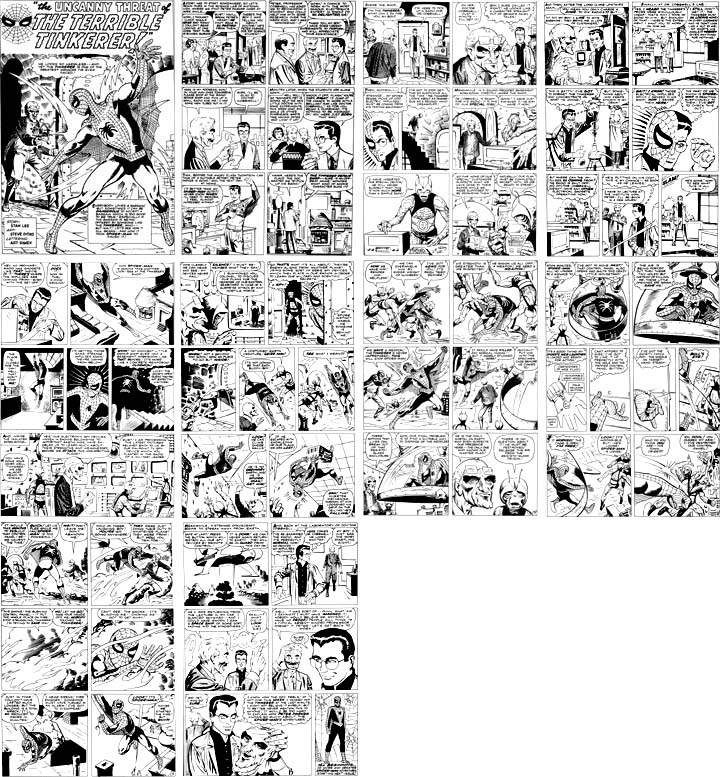
Source: The Amazing Spider-Man (vol. 1) #2 (May 1963). Written by Stan Lee. Art by Steve Ditko.
The second story (or "backup story) featured in Amazing Spider-Man #2 is a mostly forgettable tale of alien invasion featuring a mostly forgettable villain identified on the cover and splash page as "the Terrible Tinkerer." Many comic book fans who have actually heard of "the Terrible Tinkerer" probably know him primarily from having seen his name on the cover of Amazing Spider-Man #2 in trade paperback collections or reference works. While the first story in this issue introduced a character who would remain a mainstay of Spider-Man's rogues gallery, this tale would have less lasting impact.
The Tinkerer would go on to appear in other Spider-Man comics as well as other Marvel comics, but he has never been as important or as well known as many of the other villains from the earliest issues of Amazing Spider-Man.
Ironically, this is story about alien invasion. This is the first time that Peter Parker has encountered beings from another world! This story takes place early in the modern history of the modern Marvel Universe, and so there is no reason to believe that Peter Parker or the general public on Earth would have any awareness that intelligent alien life had come to Earth. One might think that the impact of this adventure would be greater than Spider-Man's previous tussles with a burglar, a spy and a magnetically-flying thief. But it doesn't. Even if Peter Parker was a science fiction buff, an active believer in UFOs, or raised in a denomination (such as the Church of Jesus Christ of Latter-day Saints) whose scriptures teach that there are intelligent people on countless other planets throughout the universe, one would think that actually meeting such aliens for the first time would seem remarkable. But Peter Parker registers only mild and momentary surprise, and the whole experience seems promptly forgotten. (By the way, there is no evidence in this story or any that preceded it that Peter Parker was a science fiction buff or a UFO believer or a Latter-day Saint.)
At the end of this story Peter Parker doesn't tell anybody about the alien invasion because he is afraid of giving away his secret identity! Objectively, this could be seen as incredibly irresponsible. Peter has no way of knowing whether the aliens will return to take over the planet, but he doesn't tell anybody!
BELOW: "One of the greatest menaces I've ever faced!":
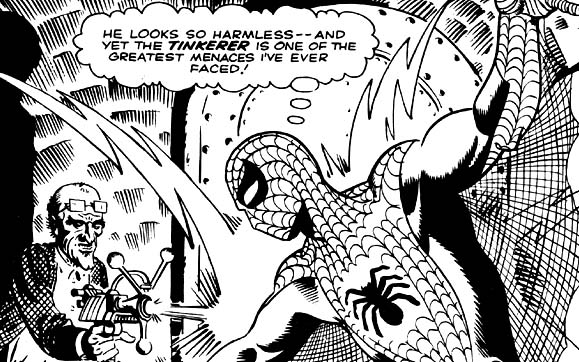
Source: The Amazing Spider-Man (vol. 1) #2 (May 1963), pg. 1, panel 1. Written by Stan Lee. Art by Steve Ditko.
The non-chronological splash page once again presents the story's title, credits, a teaser paragraph and an image based intended to capture the essense or a highlight of the story. A decrepit-looking man fires a science fiction laser weapon at Spider-Man. Spider-Man's thoughts, which exemplify Stan Lee's often hyperbolic writing style, might strike modern readers as humorous:
Text from page 1:
Spider-Man: [Thinking] He looks so harmless -- and yet the Tinkerer is one of the greatest menaces I've ever faced!
Narration: Everybody loves a bargain! But sometimes it can be dangerous to accept a bargain which is too good to be true! Especially if the bargain is being offered by someone like the Tinkerer, who -- but wait! Let's see how it all began -- and how it took Spider-Man to finish it!
This doesn't have anything to do with religion and ethics, but what is funny about this page is Spider-Man's thought that the Tinkerer is "one of the greatest menaces [he has] ever faced!" Is he really? The truth is, any super-hero and most half-trained S.H.I.E.L.D. agents probably could have defeated the Tinkerer. After reading the story, the Tinkerer still doesn't seem like much of a menace. One of Spider-Man's "greatest menaces"? Well, I suppose this is true. This is only the second issue of Spider-Man's series and even if we count the burglar who killed Uncle Ben, the Tinkerer is only the fourth "menace" that Spider-Man ever faced! The Tinkerer is apparently the vanguard of a (lame) alien invasion, so, yes, he could probably be counted as "one of the greatest menaces" out of four.
The teaser paragraph frames the story that follows as something of a morality tale: The moral to the story is that "it can be dangerous to accept a bargain which is too good to be true!" Does this story present Spider-Man with some kind of Faustian bargain, drawing on a rich tradition of deeply thought-provoking literature? Well, no. The story is literally about bargains that are too good to be true. The almost laughable invasion plan of the aliens in this story is that they offer incredible low prices on radio repairs, thus luring unsuspecting customers to use their shop. In addition to repairing the radios of New Yorkers, the aliens also implant secret listening devices in the radios so they can learn enough about us to conquer us. For modern readers, this must seem like a laughable plan, but this is a completely serious story. Suspension of disbelief requirers that we not wonder how it is that aliens advanced enough to travel light years through space to arrive on Earth are incapable of conquering us without sneaking bugs into our radios!
BELOW: Peter Parker's teachers and classmates all regard him as his school's best science student:
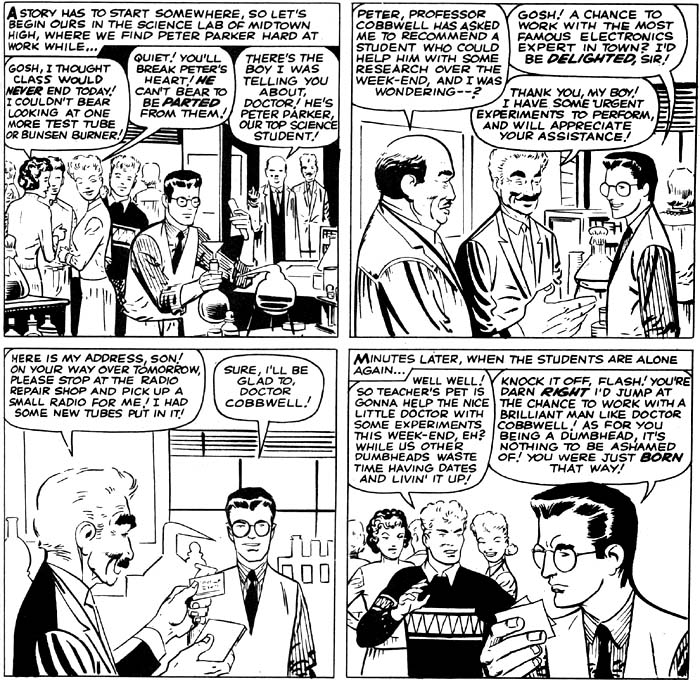
Source: The Amazing Spider-Man (vol. 1) #2 (May 1963), pg. 2, panels 1-4. Written by Stan Lee. Art by Steve Ditko.
Text from page 2, panels 1-4:
Narration: A story has to start somewhere, so let's begin ours in the science lab of Midtown High, where we find Peter Parker hard at work while . . .
Dark-haired female classmate: Gosh, I thought class would never end today! I couldn't bear looking at one mor test tube or Bunsen burner!
Liz Allan: Quiet! You'll break Peter's heart! He can't bear to be parted from them!
Science Teacher: There's the boy I was telling you about, Doctor! He's Peter Parker, our top science student!
[Peter's science teacher approaches him, accompanied by an older gentleman.]
Science Teacher: Peter, Professor Cobbwell has asked me to recommend a student who could help him with some research over the week-end, and I was wondering--?
Peter Parker: Gosh! A chance to work with the most famous electronics expert in town? I'd be delighted, sir!
Doctor Cobbwell: Here is my address, son! On your way over tomorrow, please stop at the radio repair shop and pick up a small radio for me! I had some new tubes put in it!
Peter Parker: Sure, I'll be glad to, Doctor Cobbwell!
Narration: Minutes later, when the students are alone again . . .
Flash Thompson: Well well! So teacher's pet is gonna help the nice little doctor with some experiments this week-end, eh? While us other dumbheads waste time having dates and livin' it up!
Peter Parker: Knock it off, Flash! You're darn right! I'd jump at a chance to work with a brilliant man like Doctor Cobbwell! As for you being a dumbhead, it's nothing to be ashamed of! You were just born that way!
Narration: Then, before the angry Flash Thompson can think of a suitable retort, Peter Parker is gone! And, the next day, at home . . .
Peter Parker: I'd better take my Spider-Man outfit! Never know when I'll need it! Besides, I feel almost undressed without it!
This scene on page 2 really emphasizes Parker's skill in science, as well as his genuine love of science, something which has in previous stories taken a back seat to his quest for money and his budding career as a costumed adventurer. It is worth pointing out here that Peter Parker exhibits a remarkable familiarity with scientific knowledge, purely in the way he recognizes Doctor Cobbwell on sight. Peter also expresses genuine scientific curiosity and pleasure at the opportunity to work with Doctor Cobbwell. Upon being given the chance to work with the professor, Peter's first thought is not about how much he'll get paid. He really is looking foward to it.
It is also worth noting how completely Peter's professor as well his classmates identify him with science. Note how Liz, who may already have a budding crush on Peter, jokes that he "can't bear to be parted from" his test tubes and Bunsen burners. Even while teasing Peter and standing with a crowd of kids who also tease him, Liz smiles warmly. Over the next few issues Liz Allan's romantic interest in Peter is explicitly identified, but even here it is subtly apparent.
Note how Flash Thompson refers to himself as a "dumbhead." Perhaps Flash willingly plays up to the "dumb jock" stereotype. Perhaps he secretly admires and feels a pang of jealousy for Peter Parker, a peer who so easily handles academics.
As is often the case, Peter's retort to Flash Thompson is no less biting than Flash's original jest. At this point, Peter really does seem to think that Flash Thompson is a villain. But looking at their scenes objectively, without taking Peter's side because he is the title character, it is easy to see that both young men are immature and self-centered. Even early on, it appears that Flash isn't really such a bad guy. Despite Peter's rather cutting remarks, we've never seen Flash lose control and physically assault Peter in response to being insulted by the seemingly weaker boy.
BELOW: In an image that captures Peter Parker's three principle interests (science, being Spider-Man, and earning money), our hero says he feels almost undressed without his costume:
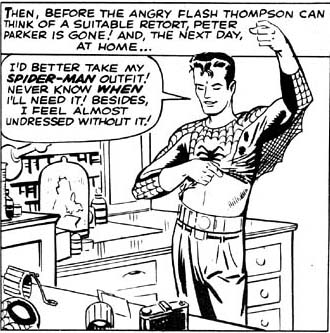
Source: The Amazing Spider-Man (vol. 1) #2 (May 1963), pg. 2, panel 5. Written by Stan Lee. Art by Steve Ditko.
Visually this page reinforces the connection between Peter Parker and science (particularly chemistry). He really is "hard at work" in the school's science lab when we first see him and even when we see his bedroom at home (page 2, panel 5) we see chemistry equipment in the background. Peter Parker's other interests are also represented in this panel. In the foreground, on another table, we see a camera (representing Peter's burgeoning career as a photographer as well as his desire to earn money) and we also see his Spider-Man mask and web-shooters. This panel thus economically captures in one image the three principle aspects of Peter Parker's character.
Note how Peter Parker says he feels "almost undressed" without his Spider-Man outfit on. As many super-heroes do, Peter quickly took to wearing his costume under his clothes and keeping it with him at all times. It is interesting how quickly Peter Parker's "Spider-Man" identity has become a core part of him, so much so that he feels undressed withou the suit.
Despite strongly identifying with his "Spider-Man" identity, Peter Parker has at this point not yet been portrayed as the sort of general protector of the city that he would eventually become. His "good deeds" in the past have been prompted by a desire to make fame and money, to protect himself, or to avenge the death of a loved one (his Uncle Ben). Perhaps Spider-Man's rescue of John Jameson was an exception to this, but perhaps it wasn't. Peter Parker was already being bothered by J. Jonah Jameson's media crusade against his Spider-Man identity, and he knew that the astronaut in trouble was Jameson's son. Peter was certain that rescuing John Jameson would win favor from his father and earn him a reprieve from the publisher's media assault. So this doesn't seem like a purely selfless act.
In this story, in which Spider-Man confronts an alien invasion led by the "Terrible Tinkerer," we might see Spider-Man's first truly selfless adventure. Spider-Man repulses an alien invasion with no apparent specific benefit for himself (other than avoiding the prospect of living under alien rule). It is possible that Spider-Man tackles this mission out of altruistic motivations, but it is also possible that he just got involved out of curiosity. On page 5 Peter's discovery of strange equipment inside a radio he picked up from the Tinkerer's shop is shown prompting more curiosity than concern.
Despite all the good that Spider-Man does in this story, he still ends up acting selfishly. As mentioned before, he neglects informing authorities or the Fantastic Four or anybody else about the alien invasion, preferring to stay silent lest his secret identity be discovered.
On page 3, Peter visits the radio repair shop (labelled "TINKERER" on the sign above the door) to pick up the radio for Doctor Cobbwell.
BELOW: The "Terrible Tinkerer" is introduced, and Spider-Man's spider-sense picks up odd electric impulses:
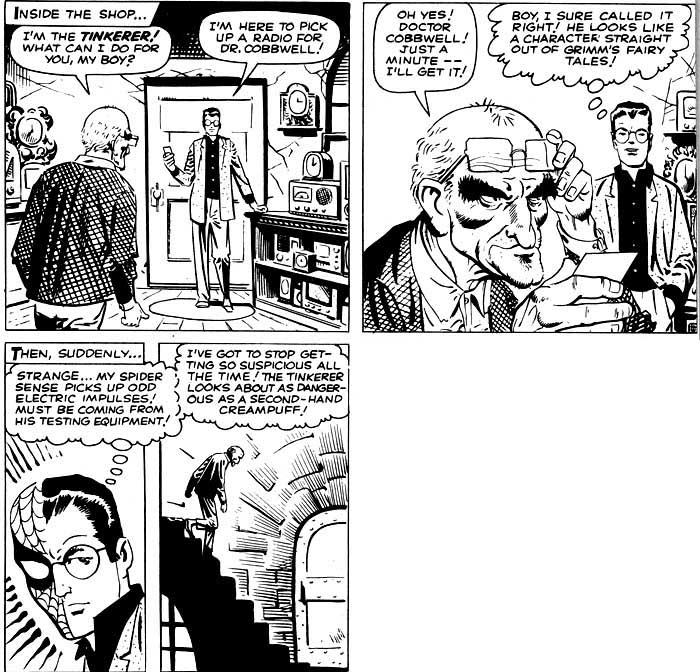
Source: The Amazing Spider-Man (vol. 1) #2 (May 1963), pg. 3, panels 1-4. Written by Stan Lee. Art by Steve Ditko.
Text from page 2, panel 6 and page 3, panels 1-4:
Peter Parker: Hmmm, here's the place the doc wanted me to pick up his radio! The Tinkerer Repair Shop -- sure is an offbeat name! Wonder what kind of kookie character runs it!
Narration: Inside the shop . . .
Tinkerer: I'm the Tinkerer! What can I do for you, my boy?
Peter Parker: I'm here to pick up a radio for Dr. Cobbwell!
Tinkerer: Oh yes! Doctor Cobbwell! Just a minute -- I'll get it!
Peter Parker: [Thinking] Boy, I sure called it right! He looks like a charater straight out of Grimm's Fairy Tales!
Narration: Then, suddenly . . .
Peter Parker: [Thinking] Strange . . . my spider sense picks up odd electric impulses! Must be coming from his testing equipment! I've got to stop getting so suspicious all the time! The Tinkerer looks about as dangerous as a second-hand creampuff!
[The Tinkerer walks down a staircase to his repair shop to retrieve Doctor Cobbwell's radio.]
Note how Spider-Man's spider sense is still less defined than it would eventually become. His spider sense picks up "strange electric impulses" in panel 3 on page 3. (Or perhaps Spider-Man simply isn't used to it and misinterprets its meaning in this scene.)
BELOW: The big reveal: The Tinkerer's low repair costs part of an alien invasion plot!
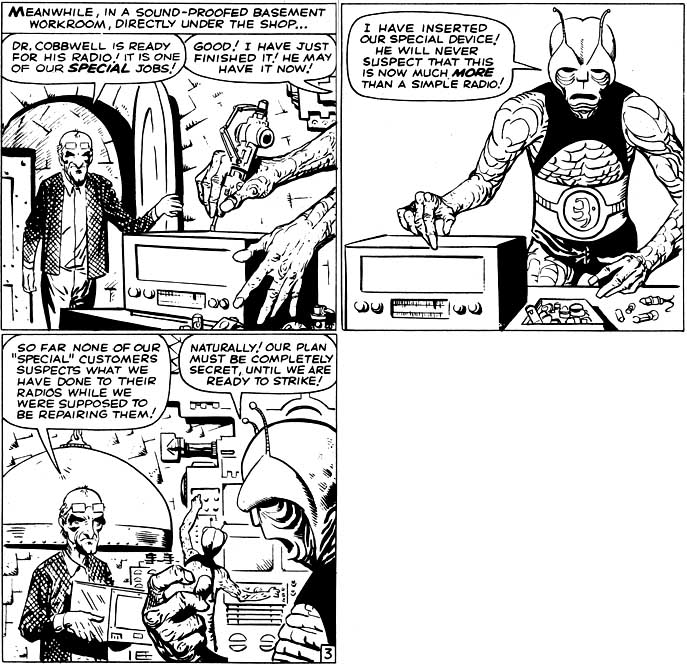
Source: The Amazing Spider-Man (vol. 1) #2 (May 1963), pg. 3, panels 5-7. Written by Stan Lee. Art by Steve Ditko.
Text from page 3, panels 5-7:
Narration: Meanwhile, in a sound-proofed basement workroom, directly under the shop . . .
Tinkerer: Dr. Cobbwell is ready for his radio! It is one of our special jobs!
Alien: Good! I have just finished it! He may have it now! I have inserted our special device! He will never suspect that this is now much more than a simple radio!
Tinkerer: So far none of our "special" customers suspects what we have done to their radios while we were supposed to be repairing them!
Alien: Natually! Our plan must be completely secret until we are ready to stike!
Is the Tinkerer an alien?
In panels 5-7 on page 3 we have the big reveal of this story: The Tinkerer's strange radio repair shop is actually part of an alien plot! Look closely at the last three panels on this page - panels showing the Tinkerer's face and build as well as the panel which shows the head and most of the body of the alien. Ditko's drawings provide a subtle but clear visual tie between the Tinkerer and the aliens. The shape of their faces and bodies, the lines under their deepset eyes, the shape of their mouths, and the spectacles on the Tinkerer's forehead compared to the forehead ridges on the alien face all provide clues that the Tinkerer is indeed a member of this alien race.
The conversation here between the Tinkerer and the alien along with conversations throughout the rest of the story also provide clues that the Tinkerer is an alien. Note how the Tinkerer always uses first-person plural pronouns "we" and "our" when speaking with the aliens. The aliens do the same when they speak with him:
Tinkerer: So far none of our "special" customers suspects what we have done to their radios while we were supposed to be repairing them!
Alien: Natually! Our plan must be completely secret until we are ready to stike!
Later Spider-Man actually pulls a mask off of the Tinkerer's face. His whole head and face, which made him appear like an elderly human, was just a mask! It is very clear to readers that the Tinkerer was an alien. Oddly enough, it is never clear whether or not Spider-Man himself realizes this. He should realize it after pulling a mask off of the Tinkerer's head, but their tussle was in a smoke-filled room, so Spider-Man never saw what the Tinkerer looked like under the mask, and we know for certain that up until that point Spider-Man thought the Tinkerer was human.
These scenes, as well as others (some of which are excerpted and commented upon below) strongly suggest that the Tinkerer is himself an alien. And yet . . . later appearances of the Tinkerer in other Spider-Man and other Marvel comics established him as a perfectly normal (albeit brilliant) Earth-born human being. This story never establishes one way or the other whether the Tinkerer is an Earthling or an alien. More about this topic will be discussed briefly at the end of this page.
BELOW: Only a dime to fix radios!
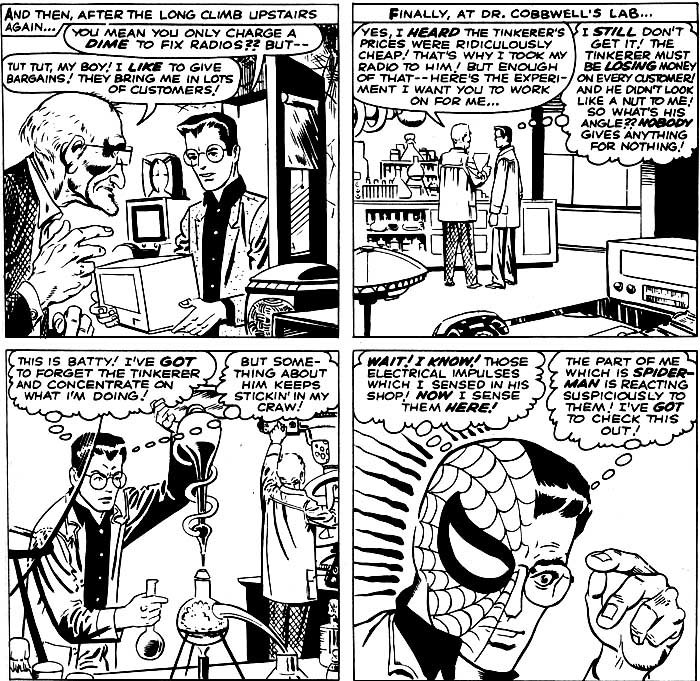
Source: The Amazing Spider-Man (vol. 1) #2 (May 1963), pg. 4, panels 1-4. Written by Stan Lee. Art by Steve Ditko.
Text from page 4, panels 1-4:
Narration: And then, after the long climb upstairs again . . .
Peter Parker: You mean you only charge a dime to fix radios?? But--
Tinkerer: Tut tut, my boy! I like to give bargains! They bring me in lots of customers!
Narration: Finally, at Dr. Cobbwell's lab . . .
Doctor Cobbwell: Yes, I heard the Tinkerer's prices were ridiculously cheap! That's why I took my radio to him! But enough of that -- here's the experiment I want you to work on for me . . .
Peter Parker: [Thinking] I still don't get it! The Tinkerer must be losing money on every customer! And he didn't look like a nut to me! So what's his angle?? Nobody gives anything for nothing! This is batty! I've got to forget the Tinkerer and concentrate on what I"m doing! But something about him keeps stickin' in my craw! Wait! I know! Those electrical impulses which I sensed in his shop! Now I sense them here! The part of me which is Spider-Man is reacting suspiciously to them! I've got to check this out!
On page 4 we see that the plot element promised in the teaser really is at the heart of this story: "a bargain which is too good to be true."
Peter Parker really dwells on this "radio repairs for a dime" deal. Peter certainly thinks about money a lot.
It is funny to see Peter Parker using test tubes and a Bunsen burner while working for the city's leading electronics expert. In Spider-Man Land all science is apparently done using test tubes and Bunsen burners. One suspects that Steve Ditko's and Stan Lee's exposure to actual science was fairly limited.
Peter Parker once again uses his spider sense in a "non-standard" way by detecting "electrical impulses" (page 4, panel 4). But is he really detecting electrical impulses? Perhaps not? Perhaps his spider sense is so powerful and prescient that his power is helping him identify danger here, even though there he is not in imminent physical danger. This seems like a possible theory if one wants to confine his spider-sense to its more modern incarnation, but this theory is not as well supported by the text as the notion that he is actually detecting strange electrical impulses.
When Dr. Cobbwell leaves Peter Parker alone in his lab to go deliver a lecture, Peter decides to investigate further. He looks inside Dr. Cobbwell's radio and sees something that looks amiss:
BELOW: Spider-Man's spider sense continues to detect strange electrical impulses:
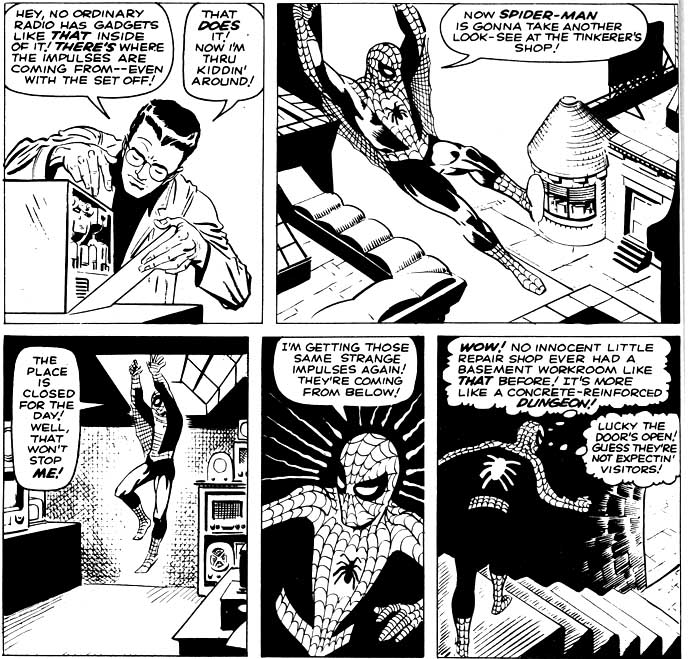
Source: The Amazing Spider-Man (vol. 1) #2 (May 1963), pg. 5, panels 1-5. Written by Stan Lee. Art by Steve Ditko.
Text from page 5, panels 1-5:
Peter Parker: Hey, no ordinary radio has gadgets like that inside of it! There's where the impulses are coming from -- even with the set off! That does it! Now I'm thru kiddin' around!
[Peter changes into his Spider-Man costume and swings over to the Tinkerer's radio repair shop.]
Spider-Man (Peter Parker): Now Spider-Man is gonna take another look-see at the Tinkerer's shop! The place is closed for the day! Well, that won't stop me! I'm getting those same strange impulses again! They're coming from below! [Thinking] Wow! No innocent little repair shop ever had a basement workroom like that before! It's more like a concrete-reinforced dungeon! Lucky the door's open! Guess they're not expectin' visitors!
BELOW: The aliens' radio repair-based plan for world conquest is further revealed:
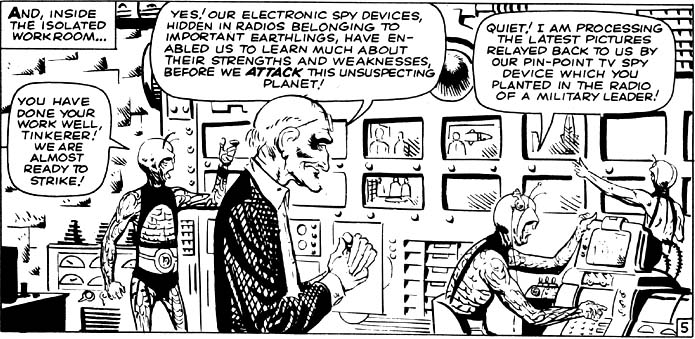
Source: The Amazing Spider-Man (vol. 1) #2 (May 1963), pg. 5, panel 6. Written by Stan Lee. Art by Steve Ditko.
Text from page 5, panel 6:
Narration: And, inside the isolated workroom . . .
Alien: You have done your work well, Tinkerer! We're almost ready to strike!
Tinkerer: Yes! Our electriconic spy devies, hidden in radios belonging to important Earthlings, have enabled us to learn much about their strengths and weaknesses, before we attack this unsuspecting planet!
Other Alien: Quiet! I am processing the latest pictures relayed back to us by our pin-point TV spy device which you planted in the radio of a military leader!
In panel 6 on page 5 the aliens' odd plot for world conquest (which hinges on offering low-cost radio repairs!) is further revealed. Note how the Tinkerer once again uses first person plural pronouns ("we"). He also refers to the people of this world as "Earthlings," a word which we Earthlings traditionally never use in reference to ourselves. Like natives of any tribe, our word for ourselves is "people." It is only foreigners, in this case aliens from another world, which use a geographically-based word to refer to our collective race. It is very clear here that the Tinkerer is himself (itself?) a member of the same alien race he is working with. He is simply the only one of them wearing an "Earthling" disguise.
BELOW: Spider-Man finally learns that aliens are responsible for the spy devices in radios:
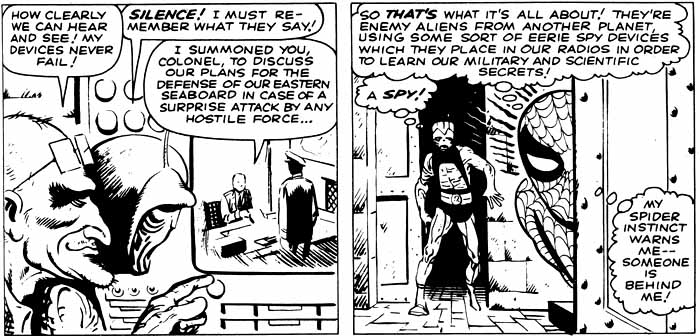
Source: The Amazing Spider-Man (vol. 1) #2 (May 1963), pg. 6, panels 1-2. Written by Stan Lee. Art by Steve Ditko.
Searching for answers, Spider-Man sneaks into the dungeon-like basement of the Tinkerer's radio repair shop. In panel 2 on page 6 Spider-Man finally sees aliens and realizes for the first time what he's really up against. He doesn't seem particularly surprised to encounter aliens, but perhaps this is simply because he doesn't have time to think about it before he is attacked by them. In panel 2 note how Spider-Man's spider sense operates in the way modern readers are accustomed to - it warns him of imminent danger.
The rest of page 6 and most of page 7 features the first big action sequence of this story. Spider-Man fights about a half-dozen aliens. He isn't very experienced at this point, but the aliens don't possess his powers and spider-strength, and they seem like even worse fighters than the inexperienced human hero. Spider-Man handily defeats the handful of un-costumed aliens, but then the Tinkerer himself gets the drop on Spider-Man and shots him with the laser gun depicted on the cover and on the story's splash page. The Tinkerer notes (page 7, panel 4) that his weapon "would have killed any normal human -- but it merely stunned" Spider-Man.
The Tinkerer and the other aliens confine the unconscious Spider-Man in a see-through hemisphere enclosure made of "Resisto-Glass." They probably should have killed him outright, but this is a mistake comic book villains often make. By confining him rather than killing him, they give Spider-Man a chance to use his wits and powers (and web-shooters) to escape out of a death trap - a scene no self-respecting comic book from this era should be without!
BELOW: The Tinkerer clearly speaks as a member of the invading alien race:
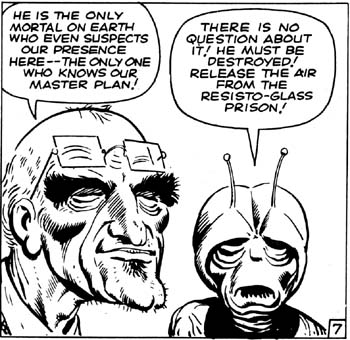
Source: The Amazing Spider-Man (vol. 1) #2 (May 1963), pg. 7, panel 6. Written by Stan Lee. Art by Steve Ditko.
After the aliens capture Spider-Man, the Tinkerer clearly speaks as a member of the invading alien race in panel 6 on page 7:
Tinkerer: He [Spider-Man] is the only mortal on Earth who even suspects our presence here -- the only one who knows our master plan!
Alien: There is no question about it! He must be destroyed! Release the air from the Resisto-Glass prison!
Spider-Man's exciting escape takes place on page 8. After escaping he is immediately spotted by the aliens. Spider-Man punches the nearest alien, conveniently causing him to jar another alien's arm so much that the jarred compatriot shoots their control panel.
The technology these aliens must be extraordinarily delicate and difficult to assemble, for this one little mishap causes them to abandon their entire plan. On page 9 they run away, leaving the Tinkerer to be tackled by Spider-Man.
BELOW: Spider-Man rather generously gives the aliens a pass because they're doing their duty, but he regards the Tinkerer as a "traitor":
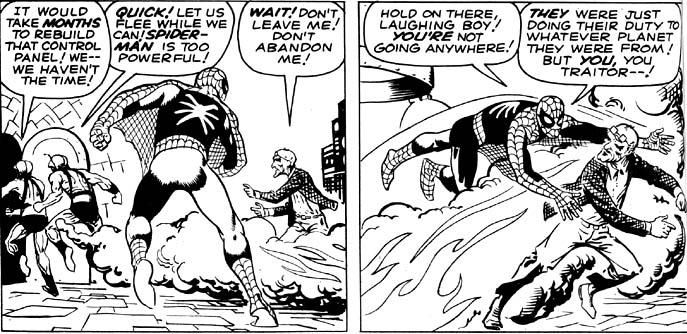
Source: The Amazing Spider-Man (vol. 1) #2 (May 1963), pg. 9, panels 1-2. Written by Stan Lee. Art by Steve Ditko.
Text from page 9, panels 1-2:
Alien: [Fleeing] It would take months to rebuild that control panel! We-- we haven't the time!
Other Alien: Quick! Let us flee while we can! Spider-Man is too powerful!
Tinkerer: Wait! Don't leve me! Don't abandon me!
Spider-Man: [Tackling the Tinkerer] Hold on there, laughing boy! You're not going anywhere! They were just doing their duty to whatever planet they were from! But you, you traitor--!
Panel 2 on page 9 is very interesting, and is very telling about Spider-Man's character. Spider-Man seems like he is giving the aliens a "pass" from a moral standpoint. He says that the aliens were "just doing their duty to whatever planet they were from," but he is angry at the Tinkerer himself, thinking the Tinkerer is a human who has turned traitor against his species. In this story Spider-Man never really exhibits any anger toward the aliens, even though he saw that they were trying to take over his planet. In all of this, Spider-Man seems rather empathetic and forgiving to the aliens, rather than fearful or hateful or any number of emotions he could have experienced.
The aliens acted much like Soviet-era Russians in this story. (Panel 1 on page 6, in which they spy on a military officer, seems particularly like something from a Cold War spy plot.) The Cold War was in full force in 1963 when this story was published. Perhaps Stan Lee consciously or unconsciously imbued the aliens and their plot with characteristics of America's Communist enemies. The general portrayal of the aliens (aside fromt he stupidity of their plot) and Spider-Man's understanding words about their actions all serve to give them a rather sympathetic portrayal in this story. They're certainly the "bad guys" of the piece, but at the end of the story, it's hard to think of them as outright "evil." Stan Lee seems to suggest that they have their own loyalties, valus and beliefs, just as we have our own. For all we know, had the aliens succeeded in conquering Earth, perhaps their rule over us would have been benevolent. It's not like they were planning on eating us or torturing us or anything.
After Spider-Man tackles the Tinkerer, smoke from a fire caused by the battle becomes so thick that Spider-Man can't see. The Tinkerer manages to escape Spider-Man's grasp and get away. As Spider-Man leaves the burning building he hears the sirens of approaching emergency vehicles. He decides to flee the scene.
BELOW: The invading aliens retreat, bested by a teen-aged super-hero:
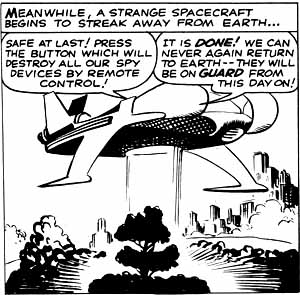
Source: The Amazing Spider-Man (vol. 1) #2 (May 1963), pg. 10, panel 1. Written by Stan Lee. Art by Steve Ditko.
Text from page 10, panel 1:
Narration: Meanwhile, a strange spacecraft begins to streak away from Earth . . .
Alien: Safe at last! Press the button which will destroy all our spy devices by remote control!
Other Alien: It is done! We can never again return to Earth -- They will be on guard from this day on!
In panel 1 on page 10 we see that the aliens decide never again to return to Earth. (Kind of wimpy aliens, if you think about it, to be bested by a high school senior only in the second issue of his comic book series.)
BELOW: Dr. Cobbwell convinces himself he did not see a space craft, while Peter Parker decides not tell anybody about the alien invasion so he can protect his secret identity:
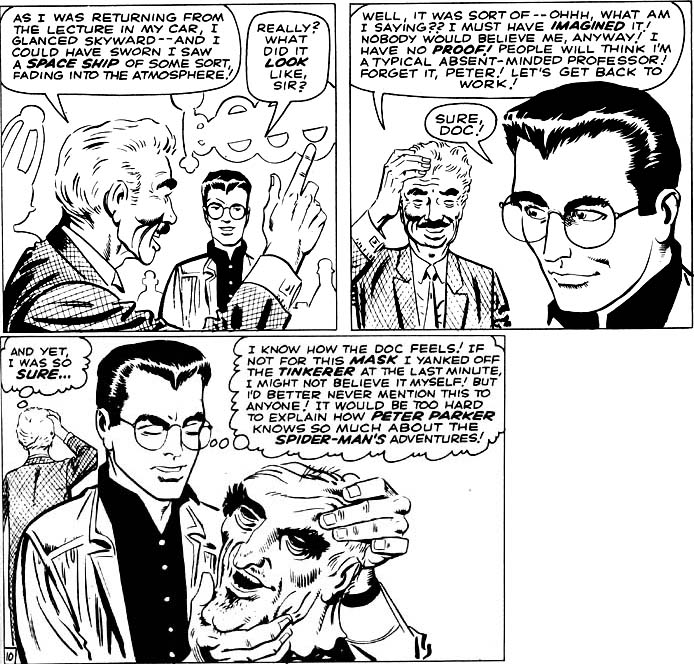
Source: The Amazing Spider-Man (vol. 1) #2 (May 1963), pg. 10, panels 3-5. Written by Stan Lee. Art by Steve Ditko.
Text from page 10, panels 2-5:
Doctor Cobbwell: My boy I just saw the most startling sight! As I was returning from the lecture in my car, I glanced skyward -- and I couold have sworn I saw a space ship of some sort, fading into the atmosphere!
Peter Parker: Really? What did it look like, sir?
Doctor Cobbwell: Well, it was sort of -- ohh, what am I saying?? I must have imagined it! Nobody would believe me, anyway! I have no proof! People will think I'm a typical absent-minded professor! Forget it, Peter! Let's get back to work!
Peter Parker: Sure, Doc!
Doctor Cobbwell: [Thinking] And yet, I was so sure . . .
Peter Parker: [Thinking] I know how the doc feels! If not for this mask I yanked off the Tinkerer at the last minute I might not believe it myself! But I'd better never mention this to anyone! It would be too hard to explain how Peter Parker knows so much about the Spider-Man's adventures!
Dr. Cobbwell returns from his lecture to find Peter Parker working in the lab. Dr. Cobbwell tells Peter that he "could have sworn [he] saw a space ship of some sort fading into the atmosphere." But the respected scientist dismisses what he saw, convincing himself that he must have imagined it.
And yet, the professor really did see an alien ship. Spider-Man himself saw the aliens, although he doesn't tell Dr. Cobbwell this. This scene is similar to other scenes in these early issues of Amazing Spider-Man in which New Yorkers expressed disbelief that Spider-Man even exists. If we can't prove that something happened, does that mean that it didn't happen? If we can't prove to others that something exists, does that mean it doesn't exist? Some people are willing to believe the words of others and accept the accounts of witnesses, while others refuse to believe in something they haven't seen for themselves.
From an extra-textual perspective, the decision by the aliens to flee from Earth and never return seems to be a convenient contrivance which eliminates the need for a complicated continuing narrative far removed from the concerns of traditional super-hero fare.
The important part of this, however, is that Spider-Man himself has no way of knowing of the aliens' decision to never return to Earth. So it seems rather irresponsible of him when he decides to not say anything about this encounter to anybody, purely out of concern for his own secret identity.
If these aliens had returned to Earth and conquered us and Spider-Man realized that his inaction had allowed them to do so when Earth could have been prepared had he said something or warned people, would this not have been an even more egregious sin of inaction than his failure to prevent a thief from escaping onto an elevator (Amazing Fantasy #15)?
On the other hand, Peter Parker's decision is understandable, if he thought that nobody would have believed him anyway. He had no physical proof (except for the Tinkerer's mask). People tend not to believe things which are outside their present worldview. Peter Parker knows this. Peter Parker's family had strong beliefs and practiced an easy-going, generic Protestantism. The Parkers were not known to have been particularly evangelical, confrontational or missionary-minded. The Parkers were evidently very tolerant of other people having different beliefs, even if they strongly disagreed with them. Peter's toleration of the invading aliens because they were simply doing their duty to their own planet is evidence of this.
Peter Parker is more comfortable with chemical reactions he can repeat and "prove" with mathematical reliability than with telling people hard-to-believe stories that they are likely to disbelieve and which he can't prove with physical evidence. His decision to not tell anybody about the alien invasion could have turned into a tactical mistake, but it is understandable given Peter's disposition and background.
Scriptures command us to "warn our neighbors" by telling them the things we know and by sharing our spiritual/religious experiences and knowledge with them. How many people are afraid to share their faith or ideology or theological positions because they feel they have no "proof", even if they feel certain that their knowledge could benefit others?
The Tinkerer: alien or human? As noted in various places above, there are many hints throughout this story that the Tinkerer is a member of the same alien race that was planning to conquer the Earth. Yet later Marvel Comics stories firmly established that the Tinkerer is really Phineas Mason, an Earth-born human. We later learn that he intentionally left a mask of his real face behind after his battle with Spider-Man in order to confuse his pursuers into thinking he was an alien. The entire alien invasion plot was a hoax cooked up by the Tinkerer, according to stories published later.
Really? In reading this story over, it is difficult to believe that, as originally conceived and written, the whole alien invasion was a cover for a completely human blackmail scheme and that the "aliens" were actually hired thugs in costumes. This explanation can fit with details of the story, but it doesn't seem to fit with the spirit of the story as originally written. Too often we see the Tinkerer and the aliens converse as if they really are aliens, saying things that the wouldn't say when enirely alone. It seems as if they are really aliens. If they are putting on a show, who is the show for? Nevertheless, we do not know for certain whether Stan Lee wrote this as a literal alien invasion story, or if he already thought of the Tinkerer and the aliens as humans at the time the story was written.
The truth is, the alien invasion plot is kind of lame and the completely human-based plot makes more sense in many ways. But we think that the story was originally written about real aliens invading Earth and that the Tinkerer himself was intended by Stan Lee to be one of the aliens. We believe the later explanation represents a retcon or at least a "new reveal" that reveals an interpretation that was not originally planned.
The fact that this original story about the Tinkerer was written by Stan Lee in 1963 and the next story to feature the Tinkerer was not published until September of 1976 (Amazing Spider-Man #160), when the character was written by a different writer (Len Wein) all strongly suggest the the Tinkerer and his cohorts were originally written as aliens and only later revised and re-explained as humans. It appears that Len Wein revisted the early but largely forgotten Amazing Spider-Man #2 and thought of a new take on the Tinkerer. Wein apparently explained the seemingly illogical elements of the "alien invasion" story so that the story in Amazing Spider-Man #2 could make better sense to more modern (13 years later) sensibilities. Had Stan Lee himself intended that the Tinkerer and the aliens were actually human criminals he (a) would have written this story differently and (b) he would have written another story about the Tinkerer in which the truth was revealed, rather than waiting 13 years for another Stan Lee would not have waited 13 years until another writer explained the real meaning of what we saw in Amazing Spider-Man #3.
From Dave Sippel, "Characters: Tinkerer" page on "SpiderFan.org" website (http://www.spiderfan.org/characters/tinkerer.html; viewed 29 January 2008):
Precious little is known about the criminal arms dealer and inventor, Phineas Mason, aka the Tinkerer. First encountered by Peter Parker after being sent to Mason's laboratory at the behest of Mr. Warren and Professor Cobbwell early in the webspinners career, he appeared to be the leader of an alien task force attempting to control the world. Though Spider-Man stopped the "invasion", the Tinkerer got away leaving behind only a rubber mask, leaving a confused Spider-Man to ponder just who or what the Tinkerer really was.
Years later, Spider-Man would learn that the Tinkerer is an ordinary man who has an extraordinary talent for anything mechanical, and his "aliens" were movie stuntmen in costumes, including his right hand man, a pre- Mysterio Quentin Beck.
From the "Tinkerer" article on Wikipedia.org (http://en.wikipedia.org/wiki/Tinkerer; viewed 29 January 2008):
Phineas Mason is a brilliant inventor who designs advanced weaponry for criminals and sometimes undertakes crimes of his own. As the Tinkerer, he runs an underground fix-it shop disguised as a radio repair shop... Tinkerer's original scheme involved the employment of a team of petty has-been stuntmen and thugs. They specialized in placing bugs into radios and blackmailing state officials and politicians.
Tinkerer once tried to present himself as an alien to confuse his pursuers by leaving a mask that looked like his face behind when he escaped from Spider-Man in a hovercraft shaped like a flying saucer...
All of this is important in understanding the Tinkerer as he exists in contemporary Marvel comics. But this later information is not really relevant in analyzing the original story from Amazing Spider-Man #2.